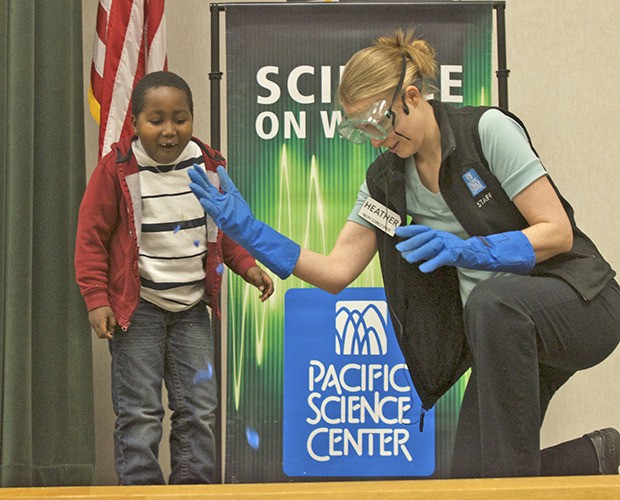Apparently the key to getting a room full of elementary school children to pay attention is liquid nitrogen, some balloons and rubber balls.
At least that’s what the parents of those kids learned at the Pacific Science Center’s Science on Wheels display Feb. 7 at the Millennium Elementary School cafeteria. The programs visit schools in the Seattle area — and throughout Washington — providing various educational programs geared around science subjects from chemistry to physics to biology.
Science on Wheels got its start in the 1970s, when PSC teachers would pack entire exhibits into their station wagons and take them to schools for displays, said Sam Chamberlain, who has worked with the productions for 20 years. Today the shows are significantly more self contained, but still manage to be intricate. The theme of the recent visit: liquid nitrogen and you, taught by Heather Bonander.
Bonander used liquid nitrogen to explain the different states of matter, showing how air in a balloon freezes into a solid, then melts to a liquid and eventually transitions back to a gas. Other experiments showed how nitrogen could freeze and shatter a solid object, or how immersing a balloon in the chemical will shrink it to where it can be placed inside a bottle.
“I think they’re wonderful, I think we need more,” said Candie Meyers, a mother who brought her two daughters and son to the show. Her son, Jon, who she said likes to experiment with anything he can get his hands on, loved the show.
Meyers’ daughters in middle and high school said that While there are many demonstrations and exhibits for early grades, there are fewer opportunities to get them involved in science outside of class projects and the science fairs. They said that more programs angled towards teens and young adults would be useful for getting older students interested in STEM subjects.
Bonander holds a degree in biology and neuroscience from Montana State and a master’s degree in evolutionary anthropology from the University of Washington, and is working at the PSC while she considers options for her future. Many of the Science on Wheels staff work with the program for a year or so in between work as they train to become teachers, Chamberlain said.
The recent visit to Kent was her first presentation with the organization since starting with them in the fall of 2013, and she felt it went well. Judging from the “ohhs,” “ahhs,” and “wows,” she was probably right.
“I was trying not to think about it too much,” she said. “Management is different in a classroom versus a show.”
Bonander said that it’s helpful to have the experience working with children in a different environment than a classroom. In a classroom setting, she said, the focus is getting students excited for the lesson, while in her presentations she has to calm them down or keep them from running up to the stage to get a closer look at what she’s doing.
Whether the 75 kids in attendance understood the whole lesson wasn’t really the point of the exhibit. The key, Bonander said, was to get the children interested in learning.
“They might remember some of the details, maybe they won’t,” she said, “but at the end of the day, they’re excited about science.”
Talk to us
Please share your story tips by emailing editor@kentreporter.com.
To share your opinion for publication, submit a letter through our website https://www.kentreporter.com/submit-letter/. Include your name, address and daytime phone number. (We’ll only publish your name and hometown.) Please keep letters to 300 words or less.

